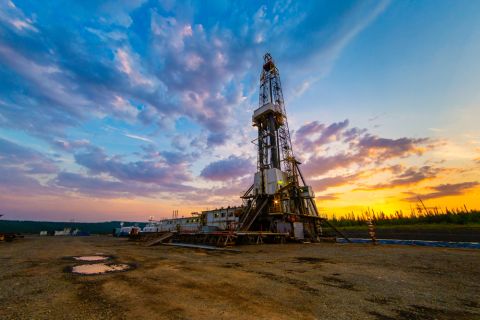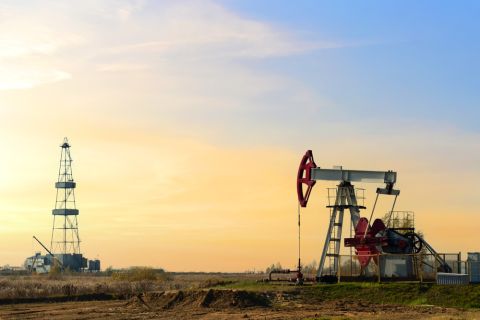Now that the unconventional plays are producing crude faster than pipelines can be laid, crude transportation by railway, particularly in North Dakota’s Bakken oil play, is becoming more prevalent by necessity.
And, according to a June 2011 report in the Williston Herald, county commissioners are reducing trucks’ weight-load limits on the area’s county roads. These restrictions are making transportation operations even more difficult for oil producers, further increasing the urgent need for gathering and transmission lines and other options to get crude to market. Added to that is the equally challenging road conditions brought about by spring rains and melted snow run-off in the area.
While several midstream companies are partnering with rail companies to move their own products to market, one company, Rangeland Energy LLC, is building a $100-million greenfield open-access storage hub and railroad facility to take oil away from Bakken wells and move it to high-value markets, whether to the east, west or south.
Rangeland Energy LLC is focused on developing, acquiring, owning and operating midstream assets in growing production areas such as the Bakken. Formed in late 2009, Rangeland Energy is an EnCap Flatrock Midstream portfolio company. Rangeland is led by Christopher W. Keene, Art Vivar and Steve Broker.
Keene is president and chief executive, and has more than 20 years of experience in the oil and gas industry, working with companies such Sunoco Logistics Partners LP, Unocal Midstream & Trade, El Paso/Tenneco Corp. and Panhandle Eastern Corp.
Vivar is executive vice president and chief financial officer, and has another 20 years in energy, working with WesPac Energy Group, Penumbra Energy Inc., Cinergy Corp., Koch Energy trading Inc. and Enron Capital & Trade resources Ltd.
Broker, the company’s executive vice president and chief operating officer, has some 25 years in midstream operations, engineering and management, and worked with Sunoco Logistics and Schlumberger Ltd., among others.
Rangeland Energy began construction of the COLT Hub in May of this year. The crude oil loading terminal and storage facility is in Williams County, North Dakota. Strategically sited in the heart of the Bakken and Three Forks oil-producing areas, COLT will provide refiners, marketers and producers with North Dakota’s first open-access crude oil marketing hub.
“We started this company a year and a half ago with a senior management team that has extensive midstream experience,” says Keene. “Our initial business plan was focused on building a crude oil business in the Bakken.”
Keene and his partners spent their first several months in the area getting a handle on what was going on in the play. They thought their initial investment opportunity would come in the form of a truck station or a pipeline.
But it eventually came together as the COLT project, says Keene. “At the outset, we looked at simply bringing in crude oil by truck, putting it into a tank, putting it on rail cars and shipping it out by unit train,” he says.
The Rangeland project took on a life of its own and as it grew and was developed into a hub. Now, Rangeland is working with other area companies to bring crude oil into the terminal by gathering pipelines as well as by trucks. The company will build the lines itself, or producers or other midstream companies may build the lines.
“Rangeland will build the tankage to provide the industry with much needed terminal services. These services could include staging the barrel, storing the barrel—whatever the customer needs,” says Keene. Rangeland will provide multiple outlets to commercialize and market the crude, primarily by pipeline and rail.
Unit trains
Specifically, Rangeland plans to build two unit-train loops. Basically, a unit-train loop is about 8,700 feet of rail, “built almost like a NASCAR track,” explains Keene. “Each loop will accommodate a unit train of up to 120 cars. The significance of being able to move crude oil by unit train is that the entire train can be loaded in less than 24 hours and move non-stop on to its ultimate market destination. This non-stop movement is critical to crude oil marketers and refiners.”
Also, the site plan calls for 14 loading arms. Imagine a 100-car train pulling in, loading 14 railcars at a time, then moving forward so 14 more will be loaded. The process can continue until all the railcars are full.
“We will be able to load a unit train in less than 24 hours,” he says. “If it can be done in less than 24 hours, the railroad company will leave the engine there until it is loaded, and then turn it around to go directly to a terminal in Cushing, Oklahoma, or to the Gulf Coast, or perhaps to a refinery on the West or East Coast. This is the fastest and cheapest way to move crude by rail.”
Although the COLT Hub will accommodate unit trains, other railway systems employ manifest trains. “Manifest is the service of moving anything less than a unit train,” Keene explains. “That could be a block of 30 cars or even 10 cars.
“If the crude moves by manifest, it may sit around waiting for the rest of the train to fill. Neither the marketers nor the refineries like that, because there is no telling when it will arrive. When you’re trading crude oil, time is money. So we are getting a lot of support from producers, marketers, and refiners for this project.”
Oil capacities
The facility will include three 120,000-barrel storage tanks for a total initial storage capacity at the COLT Hub of 360,000 barrels. By first-quarter 2012, Rangeland expects to be able to handle eight unit trains per week, and more as the facility expands. A unit train, by Burlington Northern Santa Fe Corp.’s standards, has up to 120 railcars with a capacity of some 600 barrels per car. One unit train can carries about 72,000 barrels of crude oil.
“The train won’t always arrive at the facility when it is scheduled, but we will have to keep receiving crude oil from gathering lines and trucks. As a result, we are building adequate storage capacity to accommodate scheduling issues on the railroad,” Keene explains.
The COLT Hub will be dedicated to Bakken crude oil, and will serve the immediate and surrounding counties. Keene estimates that the play will eventually produce up to 1.2 million barrels of crude per day, so the terminal will expand to serve the projected growth in production.
“In addition to the terminal, we plan to install gathering lines and other pipeline receiving facilities,” he says. “We expect to invest in excess of $100 million. That includes the COLT Hub, the 21-mile COLT Connector to Beaver Lodge-Ramberg and the gathering pipelines. We will have an operating staff of about thirty people when fully operational.”
The 10-inch-diameter COLT Connector is a bi-directional pipeline that will connect the Hub to Beaver Lodge-Ramberg, an existing pipeline hub in Williams County, North Dakota, where the Enbridge and Tesoro pipelines converge.
Rangeland began grading and preparation for the unit train loop in May and is currently building the three crude oil storage tanks.
“It is difficult to grade, with all this rain, but we are still hope to be operational in January 2012. Even if we don’t make that, we expect to be in service in first-quarter 2012. We are working closely with county and state officials, utilities and other area stakeholders as our construction activities progress.”
Major markets
Also, Rangeland is working with refiners, marketers and producers on utilization of the COLT facility. Currently, Keene sees “a big drive” to get Bakken crude down to the Gulf Coast because producers and marketers want to take advantage of the West Texas Intermediate (WTI)-Louisiana Light Sweet crude oil-price differentials. In the Bakken, the infrastructure constraints and other factors have forced producers to sell their crude oil at a discount to WTI. In some cases, this discount can be as much as $20 per barrel.
Yet, moving Bakken oil to the Gulf Coast may not be the best long-term solution, according to Keene. “There are a number of pipelines being developed to the Gulf Coast, and there will be a lot of crude coming out of the Eagle Ford that will compete with the crude from the Bakken,” he warns.
“However, there is a lot of interest in Bakken oil from crude markets on the East and West coasts. Refiners in the West and the East have an appetite for the light, sweet crude that the Bakken produces. It is unlikely that a pipeline will be built from North Dakota to Bakersfield, California, for example, or from North Dakota to the East Coast.”
And that is where rail comes into play, he says. By using rail, Bakken producers will be able to ship to premium market centers anywhere in the country.
Even where pipelines already exist, or might soon be built, oil take-away by rail still makes sense, says Keene. “We expect to have some competition from the existing and proposed pipelines with crude oil going to the Gulf Coast. We are building this hub to offer industry players in North Dakota a facility where they can aggregate barrels from multiple inbound sources, store or stage those barrels at the terminal, and provide multiple outbound market opportunities.”
In fact, if and when TransCanada Corp.’s oft-debated Keystone XL pipeline from the northern U.S. to the Gulf Coast is built, Keene wants to be able to connect the COLT Hub into that pipeline and offer additional export opportunities to Rangeland’s customers.
“There is a great deal of interest from crude markets that are not going to be touched by a pipeline. Rail will always have a future feeding refineries that are outside of a major pipeline corridor and as an additional source of supply as production increases. There will be fewer trains moving Bakken crude to the Gulf Coast, and more going to different locations.”
To further progress the project, Rangeland has established “a very good business relationship” with Burlington Northern Santa Fe Corp (BNSF), says Keene.
“Their business is to own and operate railroads, and not to own and operate crude oil tanks and rail loading facilities,” he says. The railroad company will build the tracks and infrastructure facilities to handle unit trains, and Rangeland will build the terminals that will feed their rail system. “We work with BNSF on an almost daily basis. It’s a win-win situation.”
Future concept
Keene’s vision is that the COLT Hub will eventually serve as a mini-Cushing. “I would love to be able to tie in a number of different supply sources, from a number of different counties, and connect them to a number of different export pipelines, creating a central point of trade from which Bakken crude could be sold and moved by rail to the Gulf Coast, Guernsey, Cushing, and the East or West Coast.”
Yet, not all oil assays are alike. Crude from different parts of the Bakken differs slightly in sulfur content, gravity and vapor pressure. To manage multiple customers’ inventory and their concerns about protecting crude-oil quality, Rangeland plans to implement a “common stream,” or a common specification, for the crude oil that will be handled at the hub and shipped in the COLT Connector. “There will be common specifications for sulfur content, gravity and vapor pressure. Everything that comes into the terminal will have to meet that spec,” he says.
In the future, Rangeland plans to organically grow the facility by constructing additional storage tanks and pipelines.
“We have an almost unlimited ability to expand and grow our tankage, as we have a lot of available real estate,” he says. “We could build additional tankage for crude oil or for refined products that may be imported into North Dakota by rail, such as diesel needed to fuel the oilfield-services business.” Rangeland has a little more than 300 acres in Williams County near Epping and an additional 16 acres near Beaver Lodge-Ramberg—all available for facilities expansions.
After the Bakken
Rangeland’s business strategy calls for the company to operate first in the Bakken, but it is also considering opportunities for pipelines and terminals in the Niobrara oil play in Colorado and Wyoming, and, to a lesser degree, in the Eagle Ford oil and condensate plays in South Texas.
“We are really focused on those three today. There are others out there, but we have not yet explored them,” says Keene. Meanwhile, building such a massive undertaking in North Dakota has not been easy, but undertaking any building project in the northern states never is.
“We went into construction in early May. We have only been able to work effectively about half of those days, just because it has been raining almost every day.”
Undaunted, Keene and his partners are looking forward to implementing take-away solutions for Bakken producers once the construction is complete in first-quarter 2012.
When completed, some oil will still come in by truck, but Keene expects that more will come by gathering lines as they are completed.
“That will provide more stability, so producers won’t have to shut down facilities because a truck can’t get in and out. That will be good for producers, marketers, customers and the community. It will help take truck traffic off local roads.”
Keene calls the facility the “first pure merchant or third-party terminal facility” for the area. While some producers, such as EOG Resources Inc., are building rail facilities, they do so to monetize their own production. Rangeland’s COLT Hub and Connector is a true third-party midstream system, designed to offer services to any qualified customer that has a need to commercialize their crude oil, says Keene.
Recommended Reading
Russia Orders Companies to Cut Oil Output to Meet OPEC+ Target
2024-03-25 - Russia plans to gradually ease the export cuts and focus on only reducing output.
BP Starts Oil Production at New Offshore Platform in Azerbaijan
2024-04-16 - Azeri Central East offshore platform is the seventh oil platform installed in the Azeri-Chirag-Gunashli field in the Caspian Sea.
Tinker Associates CEO on Why US Won’t Lead on Oil, Gas
2024-02-13 - The U.S. will not lead crude oil and natural gas production as the shale curve flattens, Tinker Energy Associates CEO Scott Tinker told Hart Energy on the sidelines of NAPE in Houston.
Chesapeake Enters into Long-term LNG Offtake Agreement
2024-02-13 - Chesapeake Energy entered into a long-term liquefaction offtake sale and purchase agreement with Delfin LNG and Gunvor Group for a 20-year period.
The Secret to Record US Oil Output? Drilling Efficiencies—EIA
2024-03-06 - Advances in horizontal drilling and fracking technologies are yielding more efficient oil wells in the U.S. even as the rig count plummets, the Energy Information Administration reported.



